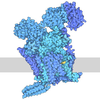+ データを開く
データを開く
- 基本情報
基本情報
| 登録情報 | データベース: PDB / ID: 9nki | |||||||||||||||
|---|---|---|---|---|---|---|---|---|---|---|---|---|---|---|---|---|
| タイトル | Structure of substrate engaged MIDN-bound human 26S proteasome, EB MIDN_UBL state (Composite map) | |||||||||||||||
 要素 要素 |
| |||||||||||||||
 キーワード キーワード | IMMUNE SYSTEM / Ubiquitin-indepedent / proteasome / MIDN-UBL / MIDN-bound 26S complex | |||||||||||||||
| 機能・相同性 |  機能・相同性情報 機能・相同性情報negative regulation of glucokinase activity / thyrotropin-releasing hormone receptor binding / nuclear proteasome complex / host-mediated perturbation of viral transcription / positive regulation of inclusion body assembly / Impaired BRCA2 translocation to the nucleus / Impaired BRCA2 binding to SEM1 (DSS1) / 加水分解酵素; プロテアーゼ; ペプチド結合加水分解酵素; オメガペプチターゼ / proteasome accessory complex / integrator complex ...negative regulation of glucokinase activity / thyrotropin-releasing hormone receptor binding / nuclear proteasome complex / host-mediated perturbation of viral transcription / positive regulation of inclusion body assembly / Impaired BRCA2 translocation to the nucleus / Impaired BRCA2 binding to SEM1 (DSS1) / 加水分解酵素; プロテアーゼ; ペプチド結合加水分解酵素; オメガペプチターゼ / proteasome accessory complex / integrator complex / purine ribonucleoside triphosphate binding / meiosis I / proteasome regulatory particle / cytosolic proteasome complex / positive regulation of proteasomal protein catabolic process / proteasome-activating activity / proteasome regulatory particle, lid subcomplex / proteasome regulatory particle, base subcomplex / metal-dependent deubiquitinase activity / protein K63-linked deubiquitination / negative regulation of programmed cell death / Regulation of ornithine decarboxylase (ODC) / Proteasome assembly / Cross-presentation of soluble exogenous antigens (endosomes) / proteasome core complex / Homologous DNA Pairing and Strand Exchange / Defective homologous recombination repair (HRR) due to BRCA1 loss of function / Defective HDR through Homologous Recombination Repair (HRR) due to PALB2 loss of BRCA1 binding function / Defective HDR through Homologous Recombination Repair (HRR) due to PALB2 loss of BRCA2/RAD51/RAD51C binding function / Resolution of D-loop Structures through Synthesis-Dependent Strand Annealing (SDSA) / Somitogenesis / Resolution of D-loop Structures through Holliday Junction Intermediates / K63-linked deubiquitinase activity / proteasomal ubiquitin-independent protein catabolic process / Impaired BRCA2 binding to RAD51 / proteasome binding / transcription factor binding / regulation of protein catabolic process / myofibril / proteasome storage granule / Presynaptic phase of homologous DNA pairing and strand exchange / general transcription initiation factor binding / blastocyst development / polyubiquitin modification-dependent protein binding / immune system process / protein deubiquitination / NF-kappaB binding / proteasome endopeptidase complex / endopeptidase activator activity / proteasome core complex, beta-subunit complex / proteasome assembly / mRNA export from nucleus / threonine-type endopeptidase activity / proteasome core complex, alpha-subunit complex / enzyme regulator activity / regulation of proteasomal protein catabolic process / inclusion body / TBP-class protein binding / proteolysis involved in protein catabolic process / proteasome complex / sarcomere / Regulation of activated PAK-2p34 by proteasome mediated degradation / Autodegradation of Cdh1 by Cdh1:APC/C / APC/C:Cdc20 mediated degradation of Securin / N-glycan trimming in the ER and Calnexin/Calreticulin cycle / Asymmetric localization of PCP proteins / Ubiquitin-dependent degradation of Cyclin D / SCF-beta-TrCP mediated degradation of Emi1 / NIK-->noncanonical NF-kB signaling / TNFR2 non-canonical NF-kB pathway / AUF1 (hnRNP D0) binds and destabilizes mRNA / stem cell differentiation / Vpu mediated degradation of CD4 / Assembly of the pre-replicative complex / Ubiquitin-Mediated Degradation of Phosphorylated Cdc25A / Degradation of DVL / Dectin-1 mediated noncanonical NF-kB signaling / Cdc20:Phospho-APC/C mediated degradation of Cyclin A / negative regulation of inflammatory response to antigenic stimulus / Degradation of AXIN / lipopolysaccharide binding / P-body / Hh mutants are degraded by ERAD / Activation of NF-kappaB in B cells / Degradation of GLI1 by the proteasome / G2/M Checkpoints / Hedgehog ligand biogenesis / GSK3B and BTRC:CUL1-mediated-degradation of NFE2L2 / Defective CFTR causes cystic fibrosis / Autodegradation of the E3 ubiquitin ligase COP1 / Negative regulation of NOTCH4 signaling / negative regulation of insulin secretion / Regulation of RUNX3 expression and activity / Vif-mediated degradation of APOBEC3G / Hedgehog 'on' state / Degradation of GLI2 by the proteasome / GLI3 is processed to GLI3R by the proteasome / FBXL7 down-regulates AURKA during mitotic entry and in early mitosis / APC/C:Cdh1 mediated degradation of Cdc20 and other APC/C:Cdh1 targeted proteins in late mitosis/early G1 / MAPK6/MAPK4 signaling 類似検索 - 分子機能 | |||||||||||||||
| 生物種 |  Homo sapiens (ヒト) Homo sapiens (ヒト) | |||||||||||||||
| 手法 | 電子顕微鏡法 / 単粒子再構成法 / クライオ電子顕微鏡法 / 解像度: 2.94 Å | |||||||||||||||
 データ登録者 データ登録者 | Peddada, N. / Beutler, B. | |||||||||||||||
| 資金援助 |  米国, 2件 米国, 2件
| |||||||||||||||
 引用 引用 |  ジャーナル: Proc Natl Acad Sci U S A / 年: 2025 ジャーナル: Proc Natl Acad Sci U S A / 年: 2025タイトル: Structural insights into the ubiquitin-independent midnolin-proteasome pathway. 著者: Nagesh Peddada / Xue Zhong / Yan Yin / Danielle Renee Lazaro / Jianhui Wang / Stephen Lyon / Jin Huk Choi / Xiao-Chen Bai / Eva Marie Y Moresco / Bruce Beutler /  要旨: The protein midnolin (MIDN) augments proteasome activity in lymphocytes and dramatically facilitates the survival and proliferation of B-lymphoid malignancies. MIDN binds both to proteasomes and to ...The protein midnolin (MIDN) augments proteasome activity in lymphocytes and dramatically facilitates the survival and proliferation of B-lymphoid malignancies. MIDN binds both to proteasomes and to substrates, but the mode of interaction with the proteasome is unknown, and the mechanism by which MIDN facilitates substrate degradation in a ubiquitin-independent manner is incompletely understood. Here, we present cryoelectron microscopy (cryo-EM) structures of the substrate-engaged, MIDN-bound human proteasome in two conformational states. MIDN induces proteasome conformations similarly to ubiquitinated substrates by using its ubiquitin-like domain to bind to the deubiquitinase RPN11 (PSMD14). By simultaneously binding to RPN1 (PSMD2) with its C-terminal α-helix, MIDN positions its substrate-carrying Catch domain above the proteasome ATPase channel through which substrates are translocated before degradation. Our findings suggest that both ubiquitin-like domain and C-terminal α-helix must bind to the proteasome for MIDN to stimulate proteasome activity. | |||||||||||||||
| 履歴 |
|
- 構造の表示
構造の表示
| 構造ビューア | 分子:  Molmil Molmil Jmol/JSmol Jmol/JSmol |
|---|
- ダウンロードとリンク
ダウンロードとリンク
- ダウンロード
ダウンロード
| PDBx/mmCIF形式 |  9nki.cif.gz 9nki.cif.gz | 4.6 MB | 表示 |  PDBx/mmCIF形式 PDBx/mmCIF形式 |
|---|---|---|---|---|
| PDB形式 |  pdb9nki.ent.gz pdb9nki.ent.gz | 表示 |  PDB形式 PDB形式 | |
| PDBx/mmJSON形式 |  9nki.json.gz 9nki.json.gz | ツリー表示 |  PDBx/mmJSON形式 PDBx/mmJSON形式 | |
| その他 |  その他のダウンロード その他のダウンロード |
-検証レポート
| 文書・要旨 |  9nki_validation.pdf.gz 9nki_validation.pdf.gz | 1.5 MB | 表示 |  wwPDB検証レポート wwPDB検証レポート |
|---|---|---|---|---|
| 文書・詳細版 |  9nki_full_validation.pdf.gz 9nki_full_validation.pdf.gz | 1.8 MB | 表示 | |
| XML形式データ |  9nki_validation.xml.gz 9nki_validation.xml.gz | 345.4 KB | 表示 | |
| CIF形式データ |  9nki_validation.cif.gz 9nki_validation.cif.gz | 530.7 KB | 表示 | |
| アーカイブディレクトリ |  https://data.pdbj.org/pub/pdb/validation_reports/nk/9nki https://data.pdbj.org/pub/pdb/validation_reports/nk/9nki ftp://data.pdbj.org/pub/pdb/validation_reports/nk/9nki ftp://data.pdbj.org/pub/pdb/validation_reports/nk/9nki | HTTPS FTP |
-関連構造データ
- リンク
リンク
- 集合体
集合体
| 登録構造単位 | 
|
|---|---|
| 1 |
|
- 要素
要素
-26S proteasome regulatory subunit ... , 5種, 5分子 ABDEF
| #1: タンパク質 | 分子量: 48700.805 Da / 分子数: 1 / 由来タイプ: 天然 / 由来: (天然)  Homo sapiens (ヒト) / 参照: UniProt: P35998 Homo sapiens (ヒト) / 参照: UniProt: P35998 |
|---|---|
| #2: タンパク質 | 分子量: 49260.504 Da / 分子数: 1 / 由来タイプ: 天然 / 由来: (天然)  Homo sapiens (ヒト) / 細胞株: HEK / 参照: UniProt: P62191 Homo sapiens (ヒト) / 細胞株: HEK / 参照: UniProt: P62191 |
| #4: タンパク質 | 分子量: 47426.141 Da / 分子数: 1 / 由来タイプ: 天然 / 由来: (天然)  Homo sapiens (ヒト) / 参照: UniProt: P43686 Homo sapiens (ヒト) / 参照: UniProt: P43686 |
| #5: タンパク質 | 分子量: 45867.027 Da / 分子数: 1 / 由来タイプ: 天然 / 由来: (天然)  Homo sapiens (ヒト) / 参照: UniProt: A0A087X2I1 Homo sapiens (ヒト) / 参照: UniProt: A0A087X2I1 |
| #6: タンパク質 | 分子量: 49266.457 Da / 分子数: 1 / 由来タイプ: 天然 / 由来: (天然)  Homo sapiens (ヒト) / 細胞株: HEK / 参照: UniProt: P17980 Homo sapiens (ヒト) / 細胞株: HEK / 参照: UniProt: P17980 |
-タンパク質 , 3種, 3分子 Cez
| #3: タンパク質 | 分子量: 45694.047 Da / 分子数: 1 / 由来タイプ: 天然 / 由来: (天然)  Homo sapiens (ヒト) / 細胞株: HEK / 参照: UniProt: P62195 Homo sapiens (ヒト) / 細胞株: HEK / 参照: UniProt: P62195 |
|---|---|
| #29: タンパク質 | 分子量: 8284.611 Da / 分子数: 1 / 由来タイプ: 天然 / 由来: (天然)  Homo sapiens (ヒト) / 細胞株: HEK / 参照: UniProt: P60896 Homo sapiens (ヒト) / 細胞株: HEK / 参照: UniProt: P60896 |
| #31: タンパク質 | 分子量: 49278.652 Da / 分子数: 1 / 由来タイプ: 組換発現 / 由来: (組換発現)  Homo sapiens (ヒト) / 遺伝子: MIDN / 発現宿主: Homo sapiens (ヒト) / 遺伝子: MIDN / 発現宿主:  |
-Proteasome subunit alpha type- ... , 7種, 14分子 GgHhIiJjKkLlMm
| #7: タンパク質 | 分子量: 27432.459 Da / 分子数: 2 / 由来タイプ: 天然 / 由来: (天然)  Homo sapiens (ヒト) / 細胞株: HEK / 参照: UniProt: P60900, proteasome endopeptidase complex Homo sapiens (ヒト) / 細胞株: HEK / 参照: UniProt: P60900, proteasome endopeptidase complex#8: タンパク質 | 分子量: 25927.535 Da / 分子数: 2 / 由来タイプ: 天然 / 由来: (天然)  Homo sapiens (ヒト) / 細胞株: HEK / 参照: UniProt: P25787, proteasome endopeptidase complex Homo sapiens (ヒト) / 細胞株: HEK / 参照: UniProt: P25787, proteasome endopeptidase complex#9: タンパク質 | 分子量: 29525.842 Da / 分子数: 2 / 由来タイプ: 天然 / 由来: (天然)  Homo sapiens (ヒト) / 細胞株: HEK / 参照: UniProt: P25789, proteasome endopeptidase complex Homo sapiens (ヒト) / 細胞株: HEK / 参照: UniProt: P25789, proteasome endopeptidase complex#10: タンパク質 | 分子量: 27929.891 Da / 分子数: 2 / 由来タイプ: 天然 / 由来: (天然)  Homo sapiens (ヒト) / 細胞株: HEK / 参照: UniProt: O14818 Homo sapiens (ヒト) / 細胞株: HEK / 参照: UniProt: O14818#11: タンパク質 | 分子量: 26484.062 Da / 分子数: 2 / 由来タイプ: 天然 / 由来: (天然)  Homo sapiens (ヒト) / 細胞株: HEK / 参照: UniProt: P28066, proteasome endopeptidase complex Homo sapiens (ヒト) / 細胞株: HEK / 参照: UniProt: P28066, proteasome endopeptidase complex#12: タンパク質 | 分子量: 29595.627 Da / 分子数: 2 / 由来タイプ: 天然 / 由来: (天然)  Homo sapiens (ヒト) / 細胞株: HEK / 参照: UniProt: P25786, proteasome endopeptidase complex Homo sapiens (ヒト) / 細胞株: HEK / 参照: UniProt: P25786, proteasome endopeptidase complex#13: タンパク質 | 分子量: 28469.252 Da / 分子数: 2 / 由来タイプ: 天然 / 由来: (天然)  Homo sapiens (ヒト) / 細胞株: HEK / 参照: UniProt: P25788, proteasome endopeptidase complex Homo sapiens (ヒト) / 細胞株: HEK / 参照: UniProt: P25788, proteasome endopeptidase complex |
|---|
-Proteasome subunit beta type- ... , 7種, 14分子 NnOoPpQqRrSsTt
| #14: タンパク質 | 分子量: 25377.652 Da / 分子数: 2 / 由来タイプ: 天然 / 由来: (天然)  Homo sapiens (ヒト) / 細胞株: HEK / 参照: UniProt: P28072, proteasome endopeptidase complex Homo sapiens (ヒト) / 細胞株: HEK / 参照: UniProt: P28072, proteasome endopeptidase complex#15: タンパク質 | 分子量: 30000.418 Da / 分子数: 2 / 由来タイプ: 天然 / 由来: (天然)  Homo sapiens (ヒト) / 細胞株: HEK / 参照: UniProt: Q99436, proteasome endopeptidase complex Homo sapiens (ヒト) / 細胞株: HEK / 参照: UniProt: Q99436, proteasome endopeptidase complex#16: タンパク質 | 分子量: 22972.896 Da / 分子数: 2 / 由来タイプ: 天然 / 由来: (天然)  Homo sapiens (ヒト) / 細胞株: HEK / 参照: UniProt: P49720, proteasome endopeptidase complex Homo sapiens (ヒト) / 細胞株: HEK / 参照: UniProt: P49720, proteasome endopeptidase complex#17: タンパク質 | 分子量: 22864.277 Da / 分子数: 2 / 由来タイプ: 天然 / 由来: (天然)  Homo sapiens (ヒト) / 細胞株: HEK / 参照: UniProt: P49721, proteasome endopeptidase complex Homo sapiens (ヒト) / 細胞株: HEK / 参照: UniProt: P49721, proteasome endopeptidase complex#18: タンパク質 | 分子量: 28510.248 Da / 分子数: 2 / 由来タイプ: 天然 / 由来: (天然)  Homo sapiens (ヒト) / 細胞株: HEK / 参照: UniProt: P28074, proteasome endopeptidase complex Homo sapiens (ヒト) / 細胞株: HEK / 参照: UniProt: P28074, proteasome endopeptidase complex#19: タンパク質 | 分子量: 26522.396 Da / 分子数: 2 / 由来タイプ: 天然 / 由来: (天然)  Homo sapiens (ヒト) / 細胞株: HEK / 参照: UniProt: P20618, proteasome endopeptidase complex Homo sapiens (ヒト) / 細胞株: HEK / 参照: UniProt: P20618, proteasome endopeptidase complex#20: タンパク質 | 分子量: 29231.178 Da / 分子数: 2 / 由来タイプ: 天然 / 由来: (天然)  Homo sapiens (ヒト) / 細胞株: HEK / 参照: UniProt: P28070, proteasome endopeptidase complex Homo sapiens (ヒト) / 細胞株: HEK / 参照: UniProt: P28070, proteasome endopeptidase complex |
|---|
-26S proteasome non-ATPase regulatory subunit ... , 11種, 11分子 VWXYZabdUcf
| #21: タンパク質 | 分子量: 61066.500 Da / 分子数: 1 / 由来タイプ: 天然 / 由来: (天然)  Homo sapiens (ヒト) / 細胞株: HEK / 参照: UniProt: O43242 Homo sapiens (ヒト) / 細胞株: HEK / 参照: UniProt: O43242 |
|---|---|
| #22: タンパク質 | 分子量: 52979.359 Da / 分子数: 1 / 由来タイプ: 天然 / 由来: (天然)  Homo sapiens (ヒト) / 細胞株: HEK / 参照: UniProt: O00232 Homo sapiens (ヒト) / 細胞株: HEK / 参照: UniProt: O00232 |
| #23: タンパク質 | 分子量: 47526.688 Da / 分子数: 1 / 由来タイプ: 天然 / 由来: (天然)  Homo sapiens (ヒト) / 細胞株: HEK / 参照: UniProt: O00231 Homo sapiens (ヒト) / 細胞株: HEK / 参照: UniProt: O00231 |
| #24: タンパク質 | 分子量: 45592.285 Da / 分子数: 1 / 由来タイプ: 天然 / 由来: (天然)  Homo sapiens (ヒト) / 細胞株: HEK / 参照: UniProt: Q15008 Homo sapiens (ヒト) / 細胞株: HEK / 参照: UniProt: Q15008 |
| #25: タンパク質 | 分子量: 37086.441 Da / 分子数: 1 / 由来タイプ: 天然 / 由来: (天然)  Homo sapiens (ヒト) / 細胞株: HEK / 参照: UniProt: P51665 Homo sapiens (ヒト) / 細胞株: HEK / 参照: UniProt: P51665 |
| #26: タンパク質 | 分子量: 42995.359 Da / 分子数: 1 / 由来タイプ: 天然 / 由来: (天然)  Homo sapiens (ヒト) / 細胞株: HEK / 参照: UniProt: Q9UNM6 Homo sapiens (ヒト) / 細胞株: HEK / 参照: UniProt: Q9UNM6 |
| #27: タンパク質 | 分子量: 40781.590 Da / 分子数: 1 / 由来タイプ: 天然 / 由来: (天然)  Homo sapiens (ヒト) / 細胞株: HEK / 参照: UniProt: P55036 Homo sapiens (ヒト) / 細胞株: HEK / 参照: UniProt: P55036 |
| #28: タンパク質 | 分子量: 39667.871 Da / 分子数: 1 / 由来タイプ: 天然 / 由来: (天然)  Homo sapiens (ヒト) / 細胞株: HEK / 参照: UniProt: P48556 Homo sapiens (ヒト) / 細胞株: HEK / 参照: UniProt: P48556 |
| #32: タンパク質 | 分子量: 105958.234 Da / 分子数: 1 / 由来タイプ: 天然 / 由来: (天然)  Homo sapiens (ヒト) / 細胞株: HEK / 参照: UniProt: Q99460 Homo sapiens (ヒト) / 細胞株: HEK / 参照: UniProt: Q99460 |
| #33: タンパク質 | 分子量: 34620.023 Da / 分子数: 1 / 由来タイプ: 天然 / 由来: (天然)  Homo sapiens (ヒト) / 細胞株: HEK Homo sapiens (ヒト) / 細胞株: HEK参照: UniProt: O00487, 加水分解酵素; プロテアーゼ; ペプチド結合加水分解酵素; オメガペプチターゼ |
| #34: タンパク質 | 分子量: 100313.625 Da / 分子数: 1 / 由来タイプ: 天然 / 由来: (天然)  Homo sapiens (ヒト) / 細胞株: HEK / 参照: UniProt: Q13200 Homo sapiens (ヒト) / 細胞株: HEK / 参照: UniProt: Q13200 |
-タンパク質・ペプチド , 1種, 1分子 v
| #30: タンパク質・ペプチド | 分子量: 1039.273 Da / 分子数: 1 / 由来タイプ: 天然 / 由来: (天然)  Homo sapiens (ヒト) Homo sapiens (ヒト) |
|---|
-非ポリマー , 4種, 10分子 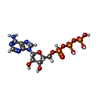

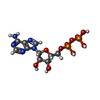




| #35: 化合物 | ChemComp-ATP / #36: 化合物 | ChemComp-MG / #37: 化合物 | ChemComp-ADP / | #38: 化合物 | ChemComp-ZN / | |
|---|
-詳細
| 研究の焦点であるリガンドがあるか | Y |
|---|---|
| Has protein modification | Y |
-実験情報
-実験
| 実験 | 手法: 電子顕微鏡法 |
|---|---|
| EM実験 | 試料の集合状態: PARTICLE / 3次元再構成法: 単粒子再構成法 |
- 試料調製
試料調製
| 構成要素 | 名称: Structure of MIDN-bound human 26S proteasome in substrate engaged state EB_MIDN_UBL タイプ: COMPLEX / Entity ID: #1-#34 / 由来: NATURAL |
|---|---|
| 由来(天然) | 生物種:  Homo sapiens (ヒト) / 株: HEK 293 Homo sapiens (ヒト) / 株: HEK 293 |
| 緩衝液 | pH: 7.6 詳細: 50 mM Tris, pH 7.5, 150 mM NaCl, 20 mM KCl,5 mM MgCl2, 1 mM TECP, |
| 試料 | 包埋: NO / シャドウイング: NO / 染色: NO / 凍結: YES / 詳細: In Vitro Reconstituted MIDN-26S proteasome complex |
| 急速凍結 | 装置: FEI VITROBOT MARK IV / 凍結剤: ETHANE / 湿度: 100 % / 凍結前の試料温度: 277 K |
- 電子顕微鏡撮影
電子顕微鏡撮影
| 実験機器 |  モデル: Titan Krios / 画像提供: FEI Company |
|---|---|
| 顕微鏡 | モデル: TFS KRIOS |
| 電子銃 | 電子線源:  FIELD EMISSION GUN / 加速電圧: 300 kV / 照射モード: FLOOD BEAM FIELD EMISSION GUN / 加速電圧: 300 kV / 照射モード: FLOOD BEAM |
| 電子レンズ | モード: BRIGHT FIELD / 倍率(公称値): 105000 X / 最大 デフォーカス(公称値): 2700 nm / 最小 デフォーカス(公称値): 1100 nm / Cs: 2.7 mm / C2レンズ絞り径: 70 µm / アライメント法: COMA FREE |
| 試料ホルダ | 試料ホルダーモデル: FEI TITAN KRIOS AUTOGRID HOLDER |
| 撮影 | 電子線照射量: 50 e/Å2 フィルム・検出器のモデル: FEI FALCON IV (4k x 4k) 撮影したグリッド数: 1 / 実像数: 17856 |
| 電子光学装置 | エネルギーフィルター名称: GIF Bioquantum |
- 解析
解析
| EMソフトウェア |
| ||||||||||||||||||||||||
|---|---|---|---|---|---|---|---|---|---|---|---|---|---|---|---|---|---|---|---|---|---|---|---|---|---|
| CTF補正 | タイプ: PHASE FLIPPING AND AMPLITUDE CORRECTION | ||||||||||||||||||||||||
| 粒子像の選択 | 選択した粒子像数: 471539 | ||||||||||||||||||||||||
| 対称性 | 点対称性: C1 (非対称) | ||||||||||||||||||||||||
| 3次元再構成 | 解像度: 2.94 Å / 解像度の算出法: FSC 0.143 CUT-OFF / 粒子像の数: 94665 / 対称性のタイプ: POINT | ||||||||||||||||||||||||
| 原子モデル構築 | プロトコル: RIGID BODY FIT / 空間: REAL | ||||||||||||||||||||||||
| 原子モデル構築 | PDB-ID: 6mse Accession code: 6mse / Source name: PDB / タイプ: experimental model | ||||||||||||||||||||||||
| 拘束条件 |
|
 ムービー
ムービー コントローラー
コントローラー

















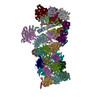
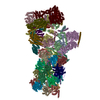
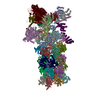
 PDBj
PDBj










